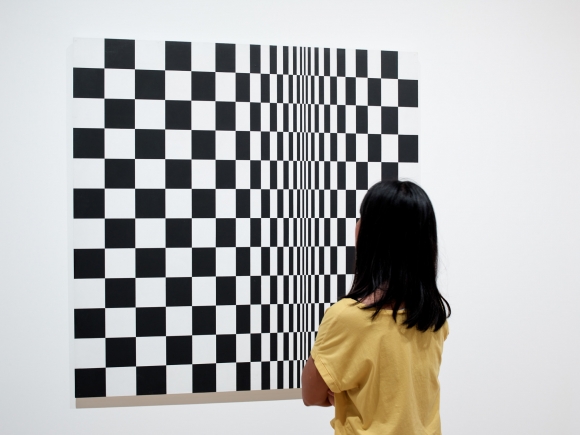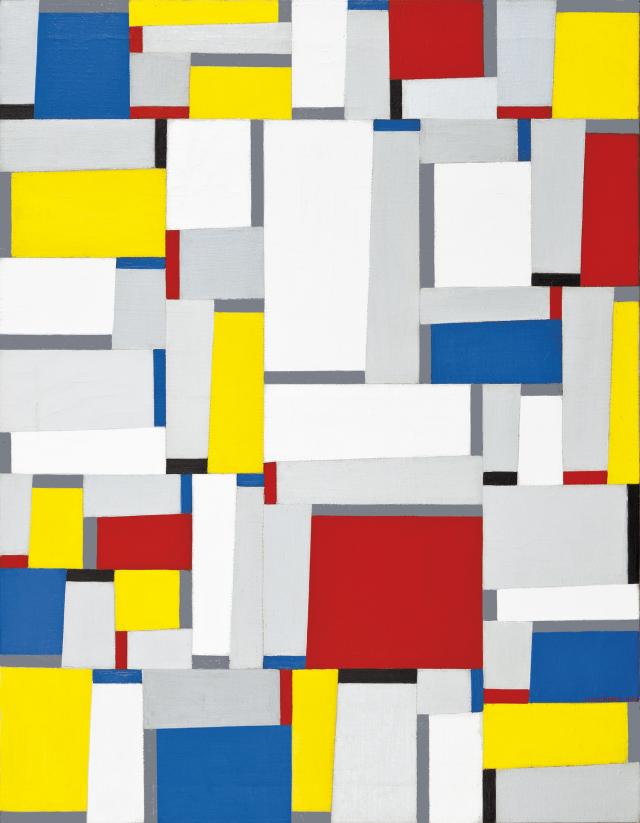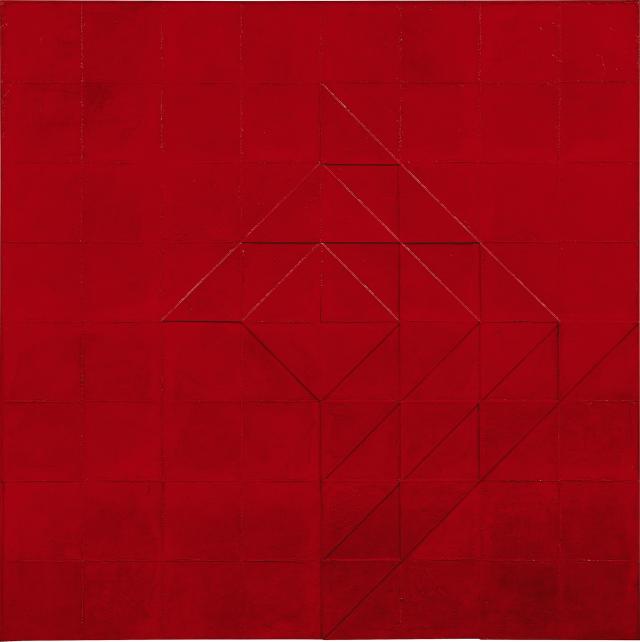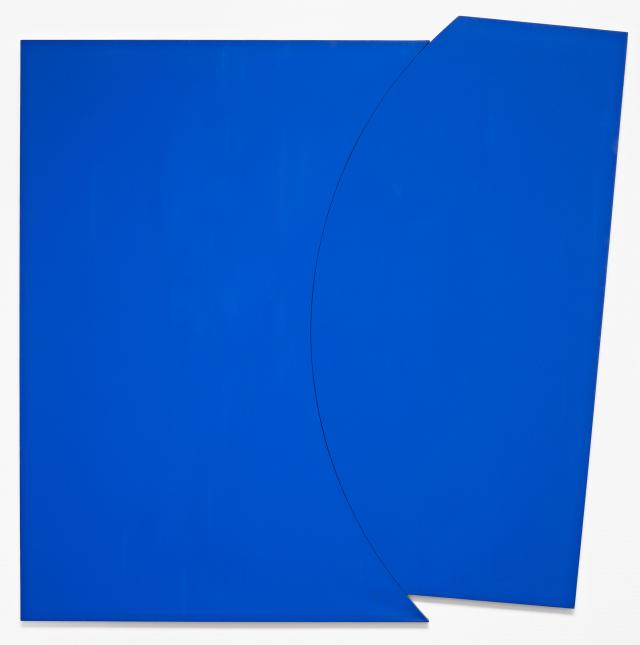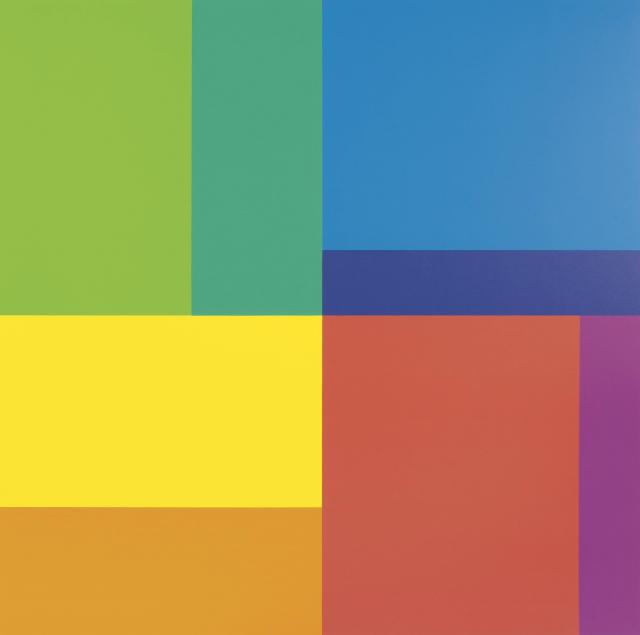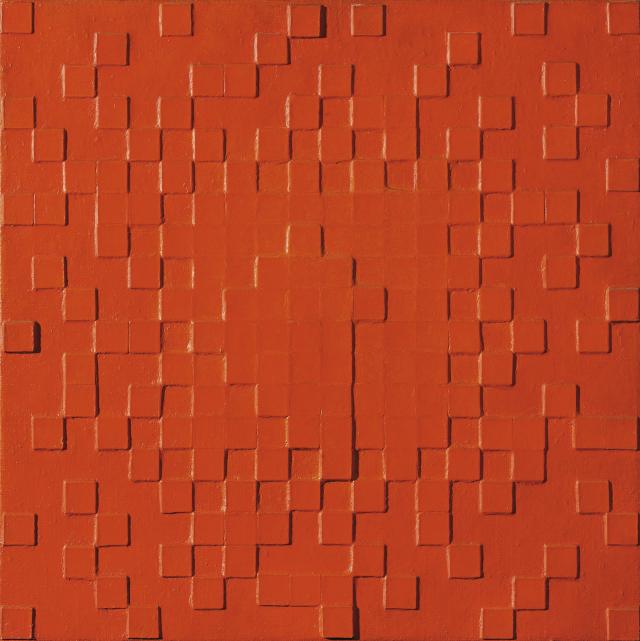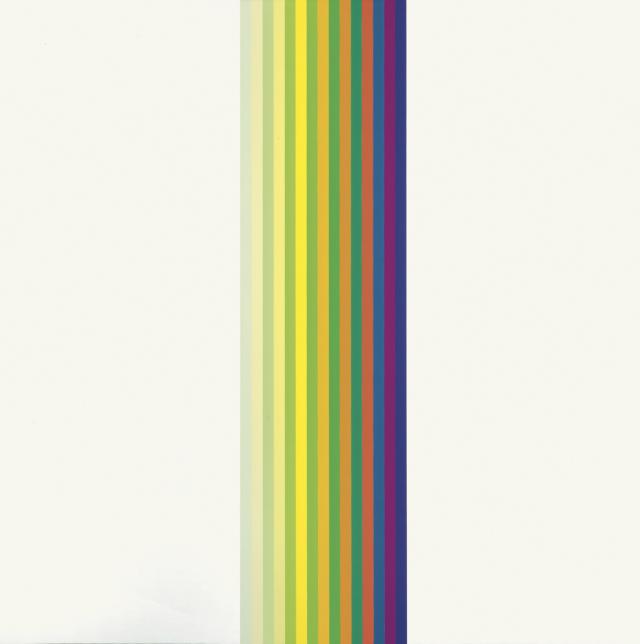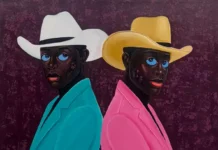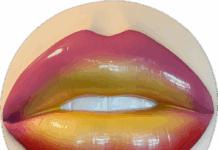Concrete Art
Definition, History, Famous Artists, Abstract Paintings.
DefinitionFirst coined by the Dutch artist and designer Theo Van Doesburg (1883-1931), the term “concrete art” refers to any type of abstract art which has no figurative or symbolic references. Thus an abstract painting whose motifs or shapes are evidently derived from any natural elements, would not be considered concrete art: the picture must be wholly devoid of any naturalistic associations. As a result, most concrete art is based on geometric imagery and patterns, and is often called geometric abstraction. To use a dietary analogy: concrete art is to abstraction, as veganism is to vegetarianism – it is the purest form. The basic idea behind this sort of pure abstraction, is to create a self-contained type of art: a sort of visual form of music.
Also, geometric abstraction is in line with classical aesthetics: Plato for example maintained that the highest form of beauty lies in the ‘ideal’ concept or geometry of a thing, rather than its actual appearance in the natural world. Finally, by having nothing to do with the material world, concrete art may be viewed as possessing a spiritual dimension. It is this spiritual dimension, for example, that underlies the “infinite pattern” designs of Islamic art. It is all a far cry from the figurative humanism of the High Renaissance. Another synonym for concretism is “non-objective art“. Early pioneers of this form of avant-garde art include Kandinsky (1866-1944), Piet Mondrian (1872-1944), and Kasimir Malevich (1878-1935).
Opposed To Abstract Expressionism
In contrast to the unemotional, geometrical iconography of concrete art, abstract expressionism is a much more emotional, sentimental and derivative form of abstraction. It may not be representational, per se, but its shapes, colours and overall design is typically based on natural world associations. Thus neither Jackson Pollock’s “action-painting”, nor Willem de Kooning’s gesturalism, nor Mark Rothko’s or Barnett Newman’s “colour field painting”, is usually classified as concretism. For a comparison of Gesturalism versus Colour Field, compare Jackson Pollock’s paintings with Mark Rothko’s paintings.
History
Geometric forms of abstract painting had appeared long before the term concrete art. Islamic art, for example, is famous for its geometrical designs such as the “infinite pattern”, as are common Celtic designs such as spirals, mazes, knots. Later, 20th century movements like Cubism (1908-14), Futurism (1909-14), and De Stijl (1917-31) all used the genre, as did Kandinsky as well as schools like the Bauhaus Design School. It was also prevalent in the international section of the famous Armory Show. But the genre was given extra attention when the term first appeared in Van Doesburg’s Manifesto of Concrete Art, which was issued in Paris in 1930. Van Doesburg argued in favour of a type of abstract art that would be entirely free of any basis in observed reality – a form also devoid of any symbolic implications. He stated that: “The work of art should obtain nothing from nature’s formal properties or from sensuality or sentimentality… Technique should be mechanistic, that is to say exact and anti-impressionistic.” In effect, Doesburg wanted to create a totally independent and self-contained form of art, which focused exclusively on itself. He saw no need for any imitation of nature, or linear perspective to create a false ‘depth’ to the painting, because he thought that nothing was more concrete (or more real) than a line, a colour, or a plane (a flat area) of colour.
Sadly, Van Doesburg passed away a year after issuing his manifesto, but his ideas were continued and developed by the Abstraction-Creation group – led by the Belgian artist Georges Vantongerloo (1886-1965) and the French painters Jean Helion (1904-87) and Auguste Herbin (1882-1960) – whose members included the cream of European abstract sculptors, such as Jean Arp (1886-1966), Naum Gabo (1890-1977), El Lissitzky (1890-1941), Antoine Pevsner (1886-1962), Barbara Hepworth (1903-1975) and Ben Nicholson (1894-1982). (Note: several of these artists later moved to non-geometric art forms, such as lyrical or biomorphic/organic abstraction).
Concrete art was later exemplified by the spiralling abstract sculpture of the Swiss ex-Bauhaus architect, sculptor and designer Max Bill (1908-94), who publicized and popularized the genre in his own country – notably, by organising the first international exhibition of concrete art in Basel in 1944 – and also introduced it to Italy, Argentina and Brazil. In keeping with the Swiss talent for minimalist graphic design and poster art, Bill’s works have been seen as precursors of minimalism in sculpture. There is a museum of Concrete art in Zurich, Switzerland.
Other abstract art movements include: (in Russia) Rayonism (Larionov), Suprematism (Malevich) and Constructivism (Rodchenko); (in Germany) the Bauhaus Design School; (in Holland) Neo-Plasticism and Elementarism; (in Italy) Movimento d’arte concreta (MAC); (in France) Espace; (in America) Hard Edge Painting (Ellsworth Kelly, Kenneth Noland and others); and Clement Greenberg’s Post-Painterly Abstraction, including Shaped Canvas (Frank Stella).
Two important collectors of concrete art include Solomon R Guggenheim (1861-1949), and Peggy Guggenheim (1898-1979).
Famous Concrete Artists From Around The World
Here is a short list of famous abstract painters listed by country.
RUSSA
Leading Russian exponents of concrete art include:
Wassily Kandinsky (1866-1944)
One of the great pioneers of abstract art.
Kasimir Malevich (1878-1935)
Founder of Suprematism.
Mikhail Larionov (1881-1964)
Founder of Rayonism.
Natalya Goncharova (1881-1962)
Co-founder of Rayonism (Luchism).
Lyubov Popova (1889-1924)
Leading Constructivist painter/designer.
El Lissitzky (1890-1941)
Known for his geometric-style ‘Proun’ paintings.
Alexander Rodchenko (1891-1956)
One of the leading Constructivist painters.
Konstantin Medunetsky (1899-1935)
Russian Constructivist artist, famous for his Colour Constructions.
NETHERLANDS/BELGIUM
Leading Dutch/Belgian exponents of geometric abstraction include:
Georges Vantongerloo (1866-1965)
Belgian founder member of De Stijl.
Piet Mondrian (1872-1944)
Member of De Stijl; founder of Neo-Plasticism.
Bart Van Der Leck (1876-1958)
One of the founders of De Stijl.
Theo van Doesburg (1883-1931)
Leader of Dutch De Stijl group; invented the term ‘concrete art’.
FRANCE
Leading French painters of non-objective art include:
Fernand Leger (1881-1955)
Semi abstract French painter, noted for his Tubism.
Auguste Herbin (1882-1960)
One of the founders of Abstraction-Creation group.
Robert Delaunay (1885-1941)
Founder of Orphism (Simultanism).
Sonia Delaunay-Turk (1885-1979)
Delaunay’s wife, noted for her colourful abstract works.
Jean Helion (1904-87)
Signed Doesburg’s Concrete Art Manifesto; member of Abstraction-Creation.
USA
Leading American geometric abstractionists include:
Tony Smith (1912-81)
American abstract sculptor.
Agnes Martin (1912-2004)
Minimalist painter, noted for her pencilled grids.
Ad Reinhardt (1913-67)
Known for his parallel red, blue, black rectangles.
Ellsworth Kelly (b.1923)
Member of American Post Painterly Abstraction school.
Kenneth Noland (b.1924)
Minimalist painter concerned with colour & structure.
Donald Judd (1928-94)
American minimalist sculptor, collected by Charles Saatchi.
Sol LeWitt (1928-2007)
Influential American minimalist sculptor, conceptual artist.
Robert Ryman (b.1930)
American minimalist painter, noted for his white monochrome compositions.
Richard Anuszkiewicz (b.1930)
American Op-art painter.
Carl Andre (b.1935)
Minimalist sculptor specializing in geometric shapes.
Frank Stella (b.1936)
Minimalist painter noted for geometric hard-edge painting & shaped canvas.
Sean Scully (b.1945)
Irish-American painter, famous for large-size, abstract paintings.
SWITZERLAND
Leading Swiss exponents of non-objective art include:
Paul Klee (1879-1940)
Swiss fantasy painter.
Johannes Itten (1888-1967)
Swiss geometric-abstractionist.
Max Bill (1908-94)
Swiss artist, promoter of concrete art in Switzerland, Italy, Argentina & Brazil.
BRITAIN
Leading British concrete artists include:
David Bomberg (1890-1957)
British abstract painter; explored Cubism, Futurism and Vorticism.
Ben Nicholson (1894-1982)
Noted for his “white reliefs” – geometric abstract relief sculpture.
Barbara Hepworth (1903-1975)
Founder with Nicholson of the St Ives School of abstraction.
Peter Sedgley (b.1930)
British Op-Art painter.
Bridget Riley (b.1931)
Leading figure in British Op-Art movement.
HUNGARY
Leading Hungarian exponents of concrete art include:
Laszlo Moholy-Nagy (1895-1946)
Hungarian Constructivist painter, Bauhaus instructor.
Victor Vasarely (1906-1997)
Hungarian graphic artist; pioneer of kinetic art/Op-Art.
REST OF THE WORLD
Frank Kupka (1871-1957)
Czech painter influenced by Futurism.
Josef Albers (1888-1976)
Famous for his Homage to the Square paintings.
Jiro Yoshihara (1905-72)
Japanese Industrialist & self-taught abstract painter.
Ivan Picelj (b.1924)
Croatian geometric abstractionist, leading member of group EXAT-51.
See also: Abstract Artists in Ireland.
Famous Paintings
Examples of concrete art can be seen in many of the best art museums around the world. Here is a small selection of such works, listed in chronological order of artist. For a larger list see: Abstract Paintings: Top 100.
• Wassily Kandinsky (1866-1944)
Harmony Squares With Concentric Rings (1913, Centre Georges Pompidou)
• Piet Mondrian (1872-1944)
Composition (1929, Guggenheim Museum, New York)
Composition With Blue And Yellow (1932, Philadelphia Museum Of Art)
Broadway Boogie-Woogie (1942, MoMA, New York)
• Bart Van Der Leck (1876-1958)
Composition (1918, Stedelijk Museum, Amsterdam)
• Kasimir Malevich (1878-1935)
Black Circle (1913, State Russian Museum, St Petersburg)
Red Square (1915, State Russian Museum, St Petersburg)
• Paul Klee (1879-1940)
Rhythmical (1930, Musee National d’Art Moderne, Centre Georges Pompidou)
• Mikhail Larionov (1881-1964)
Red Rayonism (1913, The Merzinger collection, Switzerland)
• Fernand Leger (1881-1955)
Composition (1924, State Russian Museum, St Petersburg)
• Theo Van Doesburg (1883-1931)
Composition VIII (The Cow) (1918, MoMA, New York)
• Robert Delaunay (1885-1941)
Rythme 1 (1940, Musee National d’Art Moderne, Centre Georges Pompidou)
• Josef Albers (1888-1976)
Variation in Red (1948, Private Collection)
Rain Forest (Study for Homage to the Square) (1965, Private Collection)
• Johannes Itten (1888-1967)
Benign Light (1920-21, Thyssen Collection, Lugano)
• Alexander Rodchenko (1891-1956)
Non-Objective Painting: Black on Black (1918, MoMA, New York)
• David Bomberg (1890-1957)
In The Hold (1913-14, Tate Gallery, London)
• Laszlo Moholy-Nagy (1895-1946)
Yellow Cross Q.7 (1922, Gallery of Modern art, Rome)
• Jiro Yoshihara (1905-72)
To Martha’s Memory (1970, Albright-Knox Art Gallery, Buffalo)
• Victor Vasarely (1908-97)
Untitled (1941, Israel Museum, Jerusalem)
Arny-C (1969, Artist’s Private Collection)
• Ad Reinhardt (1913-67)
Abstract Painting Diptych (1959, Private Collection)
• Ellsworth Kelly (b.1923)
Blue, Green, Yellow, Orange, Red (1966, Guggenheim Museum, New York)
• Kenneth Noland (b.1924)
Drought (1962, Tate Modern, London)
• Bridget Riley (b.1931)
Cataract 3 (1967, British Council, London)
• Frank Stella (b.1936)
Delaware Crossing (1962, Brooklyn Museum of Art)


